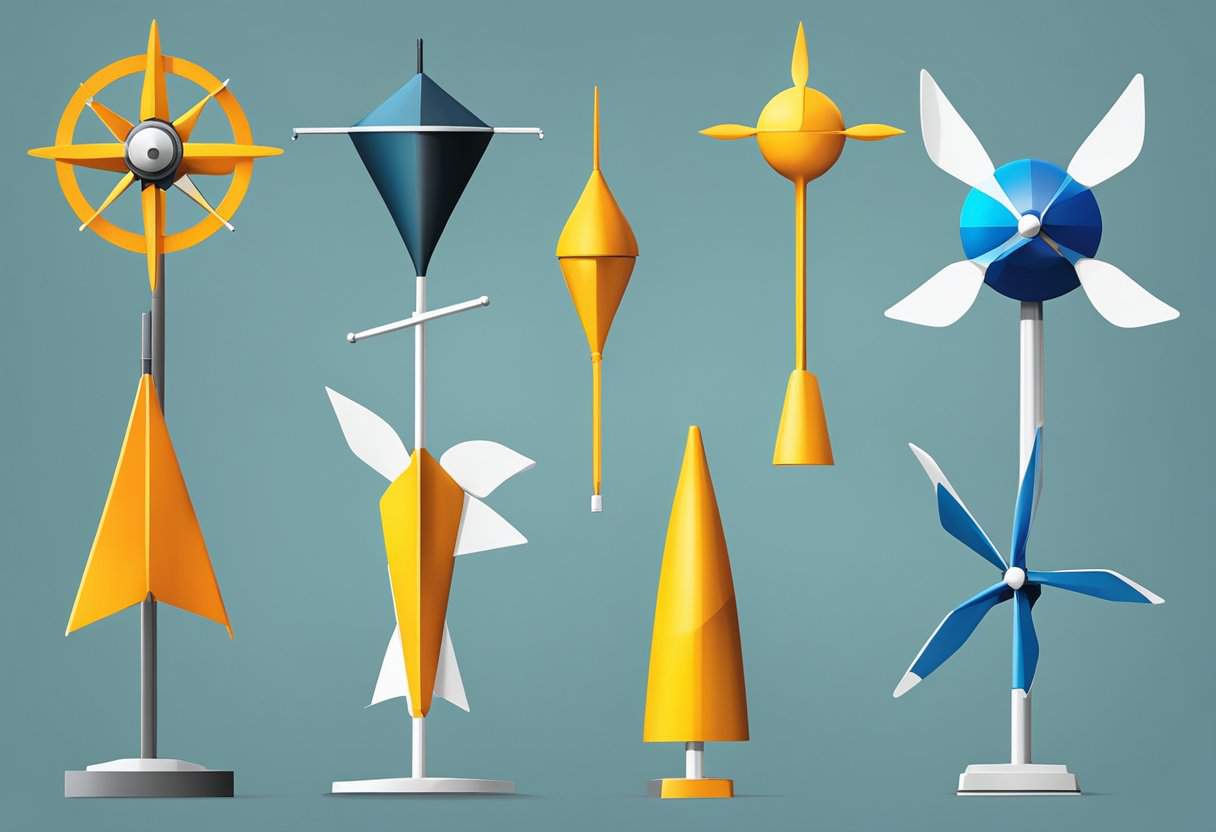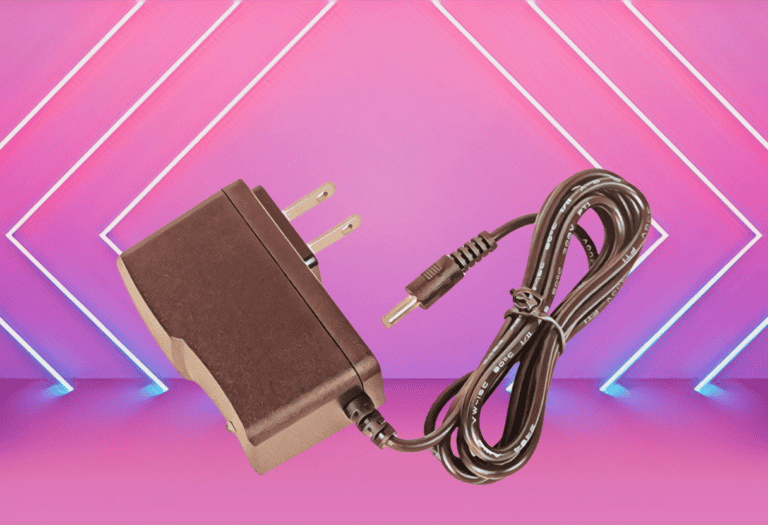Wind vanes, also known as weather vanes, are devices that have been used for centuries to determine the direction of the wind.
They are a common sight atop buildings and in gardens, serving both a practical purpose and as decorative elements. At the core of their functionality, wind vanes swivel on a fixed rod to align with the direction from which the wind blows, providing real-time wind direction data.
The basic design of a wind vane consists of an arrow or similarly shaped object that pivots freely on a vertical rod. Historically, their designs have varied from simple, functional devices to elaborate, artistic creations reflecting the cultural significance of the regions they adorn.
Beyond their aesthetic value, wind vanes play a crucial role in weather observation and are integrated into weather stations to provide vital information for meteorologists and enthusiasts alike.
Wind vanes, also known as weather vanes, function primarily to show wind direction, with variations including standard, aerovanes, and propeller anemometers catering to specific needs like speed measurement and precision in weather stations.
Historical Development of Wind Vanes
Your journey into the history of wind vanes unfolds a tale of human ingenuity in measuring wind direction. Witness the progression from primitive tools to sophisticated devices.
Origins and Ancient Use
You encounter the earliest wind vanes in ancient civilizations, where they served both practical and ornamental purposes. In Athens, atop the Tower of the Winds, a notable wind vane shaped like a triton announced the direction of the wind over 2,000 years ago. This structure emphasized the utility of wind vanes in everyday life, guiding farmers and sailors alike by indicating prevailing winds. The use of identifiable figures, like horses and roosters, began here and later cemented itself into culture and architecture.
Evolution and Technological Improvements
Over time, wind vanes evolved from mere weather instruments to intricate components of scientific research. The history of technological improvements is marked by a transition from decorative to utilitarian designs, focusing on accuracy and reliability. The evolution of wind turbines for example reflects this shift towards efficiency and functionality. Precision engineering allowed for the development of vanes with lower starting thresholds, capable of reacting to even the slightest breeze. Such advancements led to their integration into the meteorological instruments essential for weather prediction and analysis today.
By understanding their historical development, you gain an appreciation for wind vanes not only as a navigational aid but as a testament to human pursuit of mastery over the elements.
Basic Design and Functionality

A wind vane, also known as a weather vane, is an instrument that helps you determine the direction of the wind. Its design consists of a rotational axis and an aerodynamic blade that aligns with the wind flow.
Components and Construction
Your wind vane is composed of several key parts:
- Base: The support structure that often attaches to a roof or another elevated point.
- Rotational Axis: A sturdy rod allowing the wind vane to spin freely.
- Blade (Vane): Usually shaped like an arrow, it points toward the wind direction.
- Directional Markers: They are fixed relative to the base to indicate the cardinal directions (N, S, E, W).
The material used in construction varies but should withstand weather conditions and provide adequate balance and reduced friction for accurate movement.
Operating Principles
The operating principle of a wind vane is straightforward:
- Alignment with Wind: The blade is designed to catch the wind, aligning itself parallel to the wind flow.
- Rotation: The wind force causes the vane to rotate around its central axis until the blade is positioned with the smallest face against the wind, reducing resistance and pointing towards the wind’s origin.
- Direction Indication: With the directional markers, you can easily read the wind direction at the base of the structure.
Precision in the balance of the blade and a frictionless axis are crucial for the sensor to respond accurately to wind direction changes.
Types of Wind Vanes
Wind vanes, commonly referred to as weather vanes, come in various designs, each tailored to measure wind direction and sometimes speed with distinct mechanisms. As you explore the realm of wind vanes, you’ll encounter the standard weather vane, aerovanes, and the propeller anemometer, each offering unique functionalities suited for different meteorological purposes.
Standard Weather Vane
The Standard Weather Vane is your quintessential wind direction indicator, usually featuring an ornamental pointer balanced on a vertical rod. This type points to the direction from which the wind originates and is often seen atop buildings and houses. They rely on the wind’s force to rotate the pointer, aligning it with the wind’s direction.
Aerovanes
For more precise wind direction and speed readings, Aerovanes are employed. These devices combine the directional tail of a weather vane with propellers or cups to measure wind speed. You can observe aerovanes at weather stations, as they provide a comprehensive understanding of the wind’s behavior by capturing both speed and direction data.
Propeller Anemometer
Lastly, the Propeller Anemometer is specifically designed to measure wind speed, using rotating propellers aligned horizontally with the wind direction. This instrument translates the rotation speed of the propeller into wind speed, typically recorded in knots, meters per second, or miles per hour. Your encounter with propeller anemometers would likely be in scientific research or at airports where accurate wind speed data is crucial.
Comparative Analysis with Anemometers
When you evaluate the performance of wind vanes, it’s vital to understand how they stack up against different types of anemometers. Each device has its unique method of measuring wind speed and characteristics, offering various advantages in specific applications.
Cup Anemometer
Cup anemometers measure wind speed by counting the number of rotations of the cups, which is directly related to the wind speed. They are well-known for their simplicity and durability. The primary advantage of a cup anemometer over a wind vane is that it can quantitatively measure wind speed, not just direction. Studies such as the analysis on Biplane Wind Vanes have shown that cup anemometers have a certain inertia and therefore can be less responsive to gusty conditions compared to other types. While they are generally reliable, it’s important for you to consider that debris or ice can sometimes impede the movement of the cups.
Sonic Anemometer
Alternatively, sonic anemometers use ultrasonic sound waves to measure wind speed and direction. These devices offer high sensitivity and accuracy, capturing both the speed and turbulent characteristics of the wind. A comparison of anemometers for turbulence characterization has indicated that sonic anemometers can provide more detailed data on wind profiles. They do not have moving parts like cup anemometers, which eliminates the concern of mechanical wear and tear. However, you need to be aware that the accuracy of sonic anemometers can be affected by temperature stratification and obstacles that might disrupt the sound path.
In your analysis of wind measuring instruments, while wind vanes provide valuable directional data, the cup and sonic anemometers extend capabilities to include precise wind speed measurements. Each has its place in meteorological studies, aviation, and other applications where understanding wind behaviour is crucial.
Wind Vane Integration in Weather Stations
Integrating a wind vane into your weather station is crucial for monitoring wind direction with precision. The accuracy and completeness of wind data hinge on the quality and setup of these components.
Measurement Accuracy
Your wind vane’s precision is paramount for ensuring accurate weather data. A high-quality vane aligns with the wind direction promptly and consistently. Most modern weather stations leverage advanced vanes that can capture slight variations in wind direction due to their sensitive design. Notably, the response characteristics of propeller and vane wind sensors establish the core of a station’s measurement reliability. Select vanes that minimize lag and error to maintain monitoring accuracy.
Monitoring Wind Parameters
When monitoring wind parameters, your weather station must evaluate both speed and direction. The wind vane, in tandem with cup anemometers or similar devices, provides a comprehensive picture of the wind’s behavior. Studies show integrating wind vanes with other meteorological tools, like an automatic wireless weather station, can create a powerful system for real-time wind monitoring. This integration is vital for applications ranging from simple environmental assessment to complex data analysis for wind turbine yaw-adjustment under diverse atmospheric conditions. Ensure your weather station’s components work together seamlessly for effective wind monitoring.
Factors Affecting Wind Vane Performance
To ensure the accuracy and reliability of your wind vane, it’s crucial to consider various factors that can influence its performance. This includes strategic placement for optimal data collection and the ever-changing environmental conditions.
Placement and Installation
Choosing the correct placement for your wind vane is fundamental to its functionality. It should be mounted at a height that is free from obstructions with a clear flow of wind to prevent inaccurate readings. Pay attention to prevailing winds and ensure your wind vane faces them when installing. A poorly placed wind vane may yield unreliable data and fail in environmental monitoring efforts.
Environmental and Weather Conditions
Your wind vane’s performance is significantly affected by the environmental and weather conditions it is subjected to. Extreme temperatures can influence the material integrity and responsiveness of the vane. Moreover, high winds can test the durability of the wind vane, while fluctuations in pressure may impact its precision. Being aware of these conditions and their potential impact will help maintain the accuracy of wind direction measurements.
Applications of Wind Vanes
Wind vanes serve as critical instruments in various fields, offering real-time wind direction information essential for operation and safety. Each sector utilizes the data gathered by these devices to optimize performance and mitigate risks associated with wind variability.
Aviation Industry
In the aviation industry, wind vanes are installed at airports to assist with the safe takeoff and landing of aircraft. You’ll observe them near runways, providing pilots with vital wind direction data necessary for aligning their approach and departure to reduce crosswind risk.
Marine Navigation
For marine navigation, wind vanes are indispensable tools that sailors rely on. Positioned atop masts, they offer immediate wind direction insight, allowing for precise sail adjustments to harness wind power effectively, ensuring safe and efficient sea voyages.
Agricultural and Land Management
Agricultural and land management operations use wind vanes to monitor local wind conditions. This data helps you in decisions about irrigation, crop spraying, and protecting against wind-related soil erosion—activities crucial for maintaining crop health and farm productivity.
Renewable Energy Sector
In the renewable energy sector, particularly concerning wind turbines, wind vanes are integral to maximizing electricity generation. These devices measure wind direction, enabling the turbines to align correctly with the wind for optimal energy capture and efficiency in power production.
Maintenance and Durability
Proper maintenance is key to ensuring the longevity of your wind vane, and selecting an appropriately sized vane made from durable materials can greatly influence its resistance to damage.
Common Issues and Repairs
You may encounter a variety of mechanical and environmental issues that can affect your wind vane’s operation. Bearing wear, which affects how smoothly the vane rotates, can be a common mechanical problem. Look for signs such as stiffness or a noisy operation that could indicate a need for lubrication or bearing replacement. Environmental factors, such as corrosion due to exposure to the elements, can also be problematic. In coastal areas, the increased salinity can expedite the corrosion process, necessitating more frequent inspections and potentially protective coatings as a resolution.
Damage caused by severe weather, such as strong winds or lightning, is another concern. In the event of lightning, ensure you have a proper grounding mechanism in place to protect your wind vane. If storm damage occurs, parts like the vane or the anemometer cups might require replacement. Refer to your wind vane’s manual for specific troubleshooting and repair guidelines.
Material and Size Considerations
The material of your wind vane influences its durability and maintenance needs. Stainless steel and anodized aluminum are common choices known for their resistance to rust and corrosion, requiring less maintenance. On the other hand, plastic components may be less durable but are often more cost-effective.
When considering the size, remember that larger vanes can be more susceptible to damage from high winds despite their visibility advantages. Conversely, smaller vanes may be less noticeable but can withstand high wind conditions better. Ensure that the size of your wind vane is compatible with its intended location and purpose for optimal performance and minimal maintenance.
Advancements in Wind Direction Monitoring
Recent years have seen significant enhancements in how you monitor wind direction, making great strides in precision and utility for various applications. These advancements have benefited environmental monitoring and have led to more reliable and accurate data collection.
Technological Innovations
Design and implementation of opto-isolator based low cost digital anemometer with wind direction monitoring system have introduced cost-effective methods ensuring higher precision in wind direction measurement. The integration of opto-isolators minimizes noise in the electrical signal, which historically could lead to misrepresented wind patterns. These innovations provide a more stable signal processing framework, allowing you to obtain a clearer picture of wind dynamics for analysis and application in fields like agriculture and renewable energy.
Integration with Sensor Networks
The deployment of wind vanes within sensor networks marks a shift towards holistic environmental monitoring systems. Such wind vanes are now frequently part of larger networks that combine various sensors; for example, some systems specifically designed for wind energy leverage multiple wind monitoring systems to capture a panoramic view of the wind’s behavior. This strategic layering of technology provides you with data that can automatically adjust wind turbines in real time to optimize their position according to the prevailing winds, enhancing the efficiency of wind farms. By tapping into a larger network, wind direction sensors significantly contribute to a more interconnected and responsive environmental monitoring approach.
Wind Vane Variations Across Cultures
Wind vanes are not just functional instruments indicating wind direction; they also carry cultural significance, manifesting in diverse designs that vary greatly across different cultures. From ornate historical figures to stylized animals like horses, each design reflects the culture’s priorities and aesthetic values.
Cultural Significance
You will find that, in different cultures, wind vanes often serve as more than mere meteorological tools; they embody historical, spiritual, or social importance to the people who create them. For example, wind vanes on the tops of buildings in Europe often take the form of roosters, a symbol believed to ward off evil. Some Native American tribes use wind vanes adorned with figures significant to their culture, such as animals which hold totemic value.
In contrast, the Irish weather vane might be seen featuring a traditional Claddagh symbol, indicative of love, loyalty, and friendship. Similarly, La Giralda’s 16th-century sculpture/weather vane functions not just to indicate wind direction but also stands as an iconic landmark showcasing Spanish Renaissance architecture.
Design Variations
When you inspect wind vanes, their design variations tell a compelling story about the regions from which they originate. Typically, you can identify two main components in a wind vane’s design: the directional arms and the decorative figure.
-
Directional Arms: These are usually marked with cardinal points—North (N), South (S), East (E), and West (W). While the execution can be quite straightforward, some cultures incorporate intricate details or local alphabets.
-
Decorative Figure: Often, this component is where cultural expression truly shines. Many wind vanes feature animals, with the horse being a particularly popular choice due to its historical significance and iconic status in several cultures. The horse motif might be found in sleek, modern silhouettes or in more elaborate, sometimes even gilded, renderings which can indicate wealth or status.
In Scandinavian countries, you might come across wind vanes with elaborate Viking ship designs, reflective of a seafaring heritage. Meanwhile, in rural areas of the United States, it’s not uncommon to see barns topped with wind vanes that feature farm animals, among which horses are a favorite, rendered in a folk art style that speaks to the country’s agricultural roots.
Choosing the Right Wind Vane
Selecting the appropriate wind vane is crucial for accurate wind direction monitoring. It is important to consider the specific type that suits your environment and provides the resolution you need.
Assessment of Needs and Environment
Before deciding on a wind vane, assess your environment. If you’re in an area with high sun exposure, durability against UV radiation is key. In places with frequent rain, choose a vane resistant to corrosion. The right wind vane must be suitable for local conditions to ensure longevity and reliability.
Comparison of Types and Features
Types of Wind Vanes:
- Standard Vanes: Often suitable for general use in many environments.
- Aerovane: Design includes a propeller for precise wind speed measurements as well as direction.
- Windsock: Simple and visual, beneficial for quick assessments in agriculture or at airports.
Features to Consider:
- Material: Whether it’s stainless steel or plastic, ensure it withstands the conditions.
- Resolution: High-resolution vanes provide more precise readings, critical for demanding applications.
- Mounting: Ensure the vane can be securely mounted for consistent performance.
By considering these specifics, you can choose the wind vane that provides the accuracy and durability you need.
Wind Vane Accuracy and Calibration
In the realm of wind vane technology, the precision of wind direction measurements hinges on regular calibration and advanced accuracy enhancement techniques. You’ll find these processes critical for the optimal performance of these devices.
Calibration Processes
Calibration is an essential procedure to ensure that your wind vane’s readings are consistent and true to actual wind directions. The calibration process typically involves adjusting the wind vane in relation to a known reference direction under controlled conditions. For instance, you may employ wind tunnels or use field comparisons with already calibrated devices to establish accurate baselines. Specific steps include:
- Initial Benchmarking: Establishing the vane’s zero point against a fixed, known direction.
- Sensor Checks: Validating the performance of wind vane sensors, as it’s crucial for measuring wind accurately.
- Data Analysis: Reviewing calibration residuals to identify any discrepancies between the observed and known directions.
Calibration might also require you to adjust for variables that affect readings, such as dynamic misalignment. Tools like LiDAR can be useful for this purpose, providing a means to test and refine the detection methods used by your wind vane.
Accuracy Enhancement Techniques
Enhancing the accuracy of wind vanes involves implementing techniques and adjustments to reduce error margins in measurements. Key strategies include:
- Adopting Low-Threshold Mechanisms: To minimize starting errors, select wind vanes with low starting thresholds for accurate detection of wind direction right from gentle breezes.
- Dynamic Performance Testing: Comparing your wind vane’s reading with a dynamic standard can highlight responsiveness and accuracy under shifting wind conditions.
Moreover, adjustments to the wind vane based on real-world feedback, such as compensating for inaccurately read wind vectors, can fine-tune yaw-adjustment in wind turbines and help ensure their optimal alignment. Regular checks of your wind vane’s accuracy not only sustain its performance over time but allow you to trust the data you collect for crucial decision-making in wind energy production and meteorological assessments.







